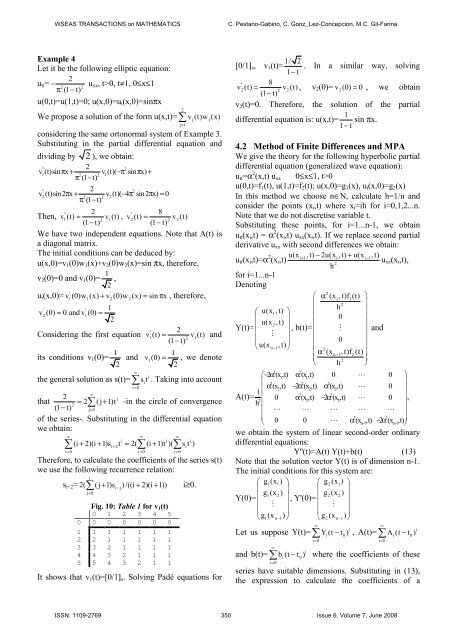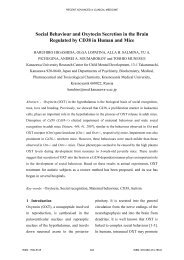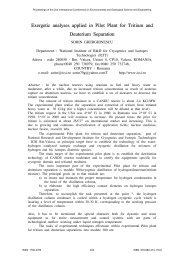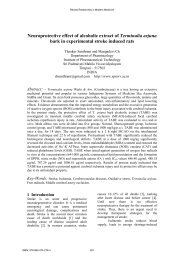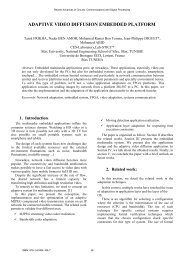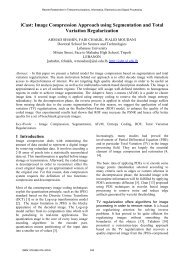The Matrix Padé Approximation in Systems of Differential ... - WSEAS
The Matrix Padé Approximation in Systems of Differential ... - WSEAS
The Matrix Padé Approximation in Systems of Differential ... - WSEAS
You also want an ePaper? Increase the reach of your titles
YUMPU automatically turns print PDFs into web optimized ePapers that Google loves.
<strong>WSEAS</strong> TRANSACTIONS on MATHEMATICSC. Pestano-Gab<strong>in</strong>o, C. Gonz_Lez-Concepcion, M.C. Gil-Far<strong>in</strong>aExample 4Let it be the follow<strong>in</strong>g elliptic equation:2u tt = − u2 2 xx , t>0, t≠1, 0≤x≤1π (1 − t)u(0,t)=u(1,t)=0; u(x,0)=u t (x,0)=s<strong>in</strong>πxWe propose a solution <strong>of</strong> the form u(x,t)= 2 vj(t)w j(x)consider<strong>in</strong>g the same ortonormal system <strong>of</strong> Example 3.Substitut<strong>in</strong>g <strong>in</strong> the partial differential equation anddivid<strong>in</strong>g by 2 ), we obta<strong>in</strong>:'' 22v1(t)s<strong>in</strong> π x+ v2 2 1(t)( −π s<strong>in</strong> π x) +π (1−t)'' 22v2(t)s<strong>in</strong>2π x + v2 2 2(t)( −4π s<strong>in</strong>2π x) = 0π (1 −t)'' 2'' 8<strong>The</strong>n, v1(t)= v2 1(t), v2(t) = v2 2(t)(1 − t)(1 − t)We have two <strong>in</strong>dependent equations. Note that A(t) isa diagonal matrix.<strong>The</strong> <strong>in</strong>itial conditions can be deduced by:u(x,0)=v 1 (0)w 1 (x)+v 2 (0)w 2 (x)=s<strong>in</strong> πx, therefore,v 2 (0)=0 and v 1 (0)= 1 2 ,∑j=1u t (x,0)= v ' (0)w (x) + v ' (0)w (x) = s<strong>in</strong> π x , therefore,''2 11 1 2 2v (0) = 0 and v (0) =Consider<strong>in</strong>g the first equation122v (t) =(1 − t)v (t)''1 2 1andits conditions v 1 (0)= 1 2 and ' 1v1(0)= , we denote2the general solution as s(t)=∞i∑ siti=0. Tak<strong>in</strong>g <strong>in</strong>to account∞2jthat = 2 (j 1)t2 ∑ + -<strong>in</strong> the circle <strong>of</strong> convergence(1 − t) j=0<strong>of</strong> the series-. Substitut<strong>in</strong>g <strong>in</strong> the differential equationwe obta<strong>in</strong>:∞ ∞ ∞i i i∑ + +i+2= ∑ + ∑ ii= 0 i= 0 i=0(i 2)(i 1)s t 2( (i 1)t )( s t )<strong>The</strong>refore, to calculate the coefficients <strong>of</strong> the series s(t)we use the follow<strong>in</strong>g recurrence relation:is i+2 = 2( ∑ (j+ 1)si−j) /((i + 2)(i + 1)) i≥0.j=0Fig. 10: Table 1 for v 1 (t)0 1 2 3 4 50 0 0 0 0 0 01 1 1 1 1 1 12 2 1 1 1 1 13 3 2 1 1 1 14 4 3 2 1 1 15 5 4 3 2 1 1It shows that v 1 (t)=[0/1] s . Solv<strong>in</strong>g Padé equations for[0/1] s , v 1 (t)= 1/ 2 . In a similar way, solv<strong>in</strong>g1−t'' 8v2(t) = v2 2(t) , v 2 (0)= v ' 2(0) = 0 , we obta<strong>in</strong>(1 − t)v 2 (t)=0. <strong>The</strong>refore, the solution <strong>of</strong> the partialdifferential equation is: u(x,t)= 1 s<strong>in</strong> πx.1−t4.2 Method <strong>of</strong> F<strong>in</strong>ite Differences and MPAWe give the theory for the follow<strong>in</strong>g hyperbolic partialdifferential equation (generalized wave equation):u tt =α 2 (x,t) u xx 0≤x≤1, t>0u(0,t)=f 1 (t), u(1,t)=f 2 (t); u(x,0)=g 1 (x), u t (x,0)=g 2 (x)In this method we choose n∈N, calculate h=1/n andconsider the po<strong>in</strong>ts (x i ,t) where x i =ih for i=0,1,2...n.Note that we do not discretise variable t.Substitut<strong>in</strong>g these po<strong>in</strong>ts, for i=1...n-1, we obta<strong>in</strong>u tt (x i ,t) = α 2 (x i ,t) u xx (x i ,t). If we replace second partialderivative u xx with second differences we obta<strong>in</strong>:u tt (x i ,t)=α 2 u(xi+ 1, t) − 2u(xi, t) + u(xi−1, t)(x i ,t) u2xx (x i ,t),hfor i=1...n-1Denot<strong>in</strong>g2⎛ α (x1, t)f1(t)⎞⎜2 ⎟⎛ u(x1, t) ⎞ ⎜ h ⎟⎜ ⎟ ⎜ 0 ⎟u(x2, t)Y(t)= ⎜ ⎟ ⎜⎟, b(t)=⎜ ⋮ ⎟ ⎜⋮⎟and⎜ ⎟ ⎜ 0 ⎟⎝ u(xn−1, t) ⎠ ⎜⎟2α (xn−1, t)f2(t)⎜2 ⎟⎝ h ⎠2 2⎛−2 α (x,t)1α (x,t)10 ⋯ 0 ⎞⎜ 2 2 2⎟(x2,t) 2 (x2,t) (x2,t) 01⎜ α − α α ⋯⎟2 2A(t)= ⎜20 α (x3,t) −2 α(x 3,t) ⋯ 0 ⎟,h ⎜⎟⎜ ⋯ ⋯ ⋯ ⋯ ⋯ ⎟⎜2 20 0 α (xn−1 ,t) −2 α (xn−1,t) ⎟⎝⋯⎠we obta<strong>in</strong> the system <strong>of</strong> l<strong>in</strong>ear second-order ord<strong>in</strong>arydifferential equations:Y''(t)=A(t) Y(t)+b(t) (13)Note that the solution vector Y(t) is <strong>of</strong> dimension n-1.<strong>The</strong> <strong>in</strong>itial conditions for this system are:⎛ g1(x 1)⎞ ⎛ g2(x1)⎞⎜ ⎟ ⎜ ⎟g1(x 2)Y(0)= ⎜ ⎟ , Y'(0)= ⎜g2(x2)⎟⎜ ⋮ ⎟ ⎜ ⋮ ⎟⎜ ⎟ ⎜ ⎟⎝g 1(x n−1)⎠ ⎝g 2(xn−1)⎠Let us suppose Y(t)=∞∞∑i=0iY (t − t ) , A(t)=i 0∞∑i=0iA (t − t )i 0iand b(t)= ∑ bi(t − t0) where the coefficients <strong>of</strong> thesei=0series have suitable dimensions. Substitut<strong>in</strong>g <strong>in</strong> (13),the expression to calculate the coefficients <strong>of</strong> aISSN: 1109-2769 350 Issue 6, Volume 7, June 2008


